
The Thomisidae are a family of spiders, including about 170 genera and over 2,100 species. The common name crab spider is often linked to species in this family, but is also applied loosely to many other families of spiders. Many members of this family are also known as flower spiders or flower crab spiders.

Lynx spider (Oxyopidae) is a family of araneomorph spiders first described by Tamerlan Thorell in 1870. Most species make little use of webs, instead spending their lives as hunting spiders on plants. Many species frequent flowers in particular, ambushing pollinators, much as crab spiders do. They tend to tolerate members of their own species more than most spiders do, and at least one species has been identified as exhibiting social behaviour.
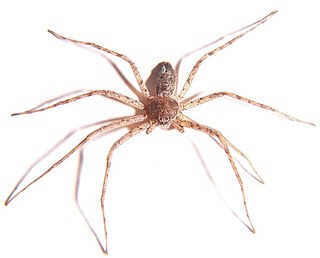
Philodromidae, also known as philodromid crab spiders and running crab spiders, is a family of araneomorph spiders first described by Tord Tamerlan Teodor Thorell in 1870. It contains over 500 species in thirty genera.
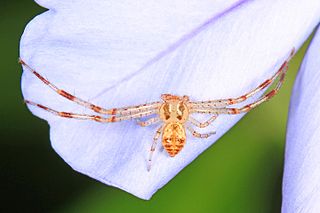
Misumenops is a common genus of crab spider with more than 50 described species.
Henriksenia nepenthicola, synonym Misumenops nepenthicola, is a species of crab spider. It is native to Singapore. It lives inside the pitchers of a number of lowland Nepenthes pitcher plants. As such, it is classified as a nepenthephile. They are slow-moving spiders which do not actively hunt. Males and females both reach a length of 6 mm.

Ochyroceratidae is a six-eyed spider family, with 165 described species in ten genera. They are common inhabitants of caves and the tropical forest litter of South Africa, the Caribbean, Asia and South America. Considered an ecological counterpart of the Linyphiidae of the northern temperate zone, species are especially diverse in the Indo-Pacific region.

Aphantochilus is a genus of ant-mimicking crab spiders that was first described by Octavius Pickard-Cambridge in 1871. As of June 2020 it contains three species, found in Paraguay, Brazil, Argentina, and Panama: A. cambridgei, A. inermipes, and A. rogersi. It is a senior synonym of Cryptoceroides.
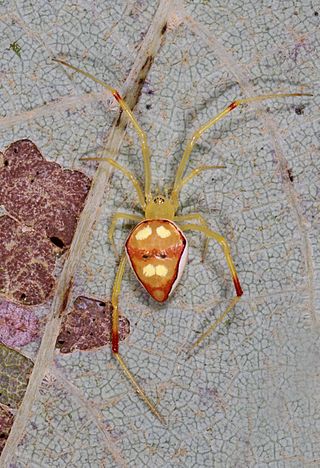
The spider genus Spintharus occurs from the northeastern United States to Brazil. Nicholas Marcellus Hentz circumscribed the genus in 1850, initially as a monospecific genus containing his newly described species S. flavidus.

Alcimochthes is a genus of Asian crab spiders that was first described by Eugène Louis Simon in 1885. As of June 2020 it contains three species, found in eastern Asia: A. limbatus, A. melanophthalmus, and A. meridionalis.
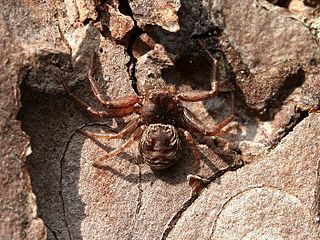
Coriarachne is a genus of crab spiders that was first described by Tamerlan Thorell in 1870. Over half of described species have been synonymized or moved to similar genera, including Bassaniana, Bassaniodes, and Pycnaxis.

Bassaniana, commonly called bark crab spiders, is a widespread genus of crab spiders that was first described by Embrik Strand in 1928.
Epidius is a genus of crab spiders that was first described by Tamerlan Thorell in 1877. It is a senior synonym of Pothaeus.
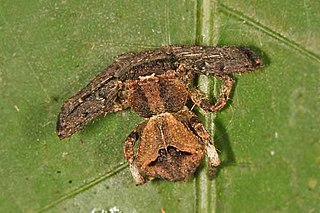
Angaeus is a genus of Asian crab spiders first described by Tamerlan Thorell in 1881. It is considered a senior synonym of Paraborboropactus.
Ansiea is a genus of crab spiders that was first described by Pekka T. Lehtinen in 2004. This genus was named in honour of South African arachnologist Ansie Dippenaar-Schoeman. As of June 2020 it contains two species found in Africa and Saudi Arabia: A. buettikeri and A. tuckeri.
Cebrenninus is a genus of crab spiders that was first described by S. P. Benjamin in 2016. It is a senior synonym of Ascurisoma.
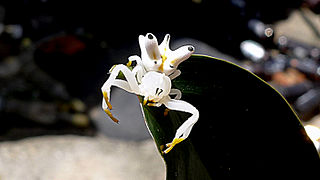
Epicadus is a genus of crab spiders that was first described by Eugène Louis Simon in 1895. It is considered a senior synonym of Tobias.

Apollophanes is a genus of running crab spiders that was first described by Octavius Pickard-Cambridge in 1898.

Misumenops bellulus is a species of crab spider in the family Thomisidae. It is found in the USA, Cuba, and the Virgin Islands.

Mecaphesa asperata, the northern crab spider, is a species of crab spider in the family Thomisidae, found in North and Central America, and the Caribbean. It is a species of the 'flower spiders', so-called because they generally hunt in similarly coloured flowers for visitors such as bees and flies, and is a much smaller nearctic relative of the better-known Goldenrod Spider.
Spiracme is a genus of crab spiders erected by Anton Menge in 1876 to contain S. striata, transferred from Xysticus. The exact relationship of these spiders and their closest relatives has been long debated, and many included species have been transferred to and from similar genera, namely Xysticus and Ozyptila. Most recently, Rainer Breitling conducted a DNA barcoding study in 2019 and grouped similar species based on the results:














